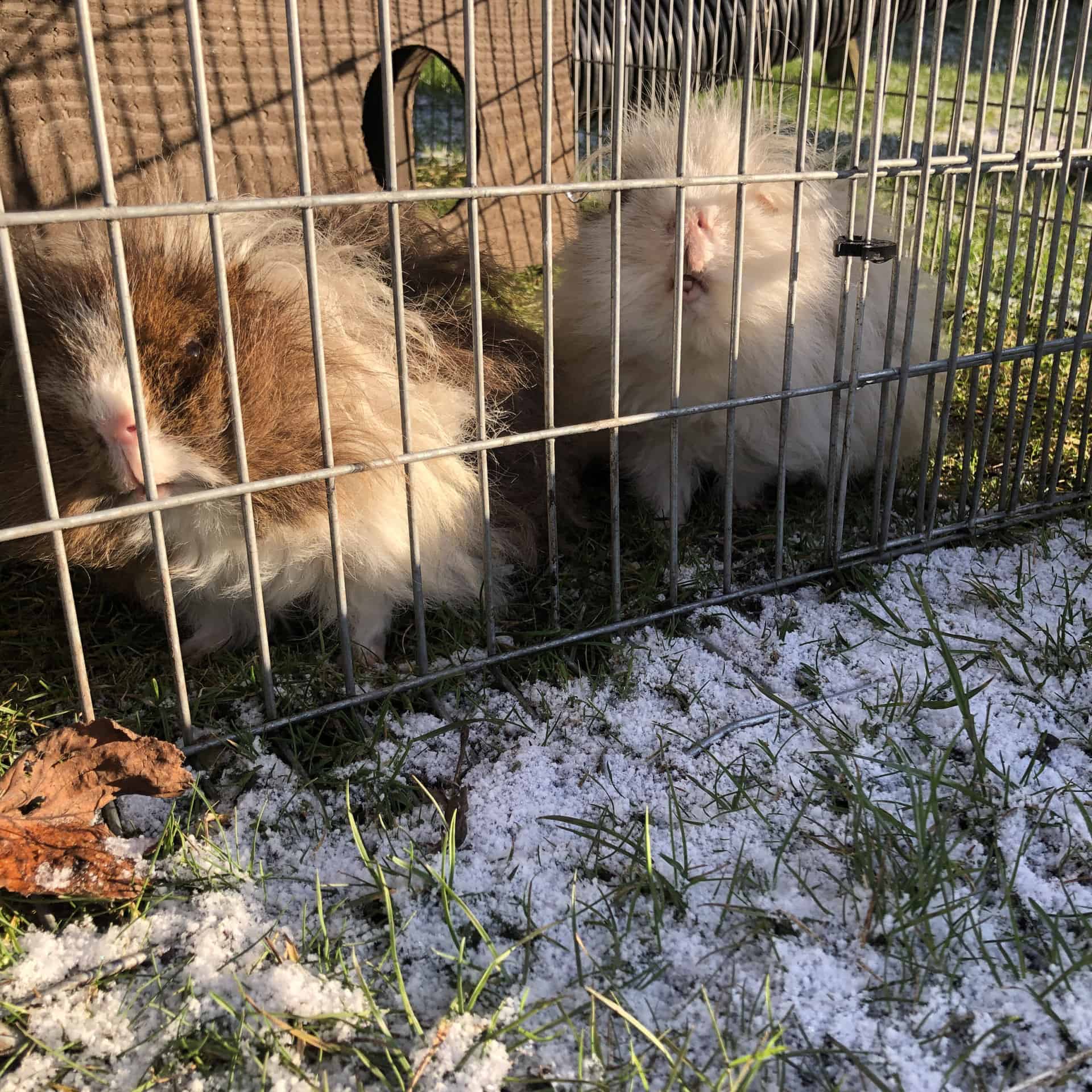Blog by Caroline Dore, Runaround founder.
Keeping outdoor guinea pigs snug
It’s not uncommon for owners to worry about colder temperatures for outdoor guinea pigs when the seasons start to change. With our Runaround rescue guinea pigs living outside all year round, we keep an extra eye on them this time of year particularly as they adapt to cooler temperatures. We have never resorted to bringing them inside however, with the thought that a completely different environment and temperature would be a double shock to them.
In their natural habitat, Peru, they would manage extremes of temperature – cold nights, hot days. They would have a series of tunnels to use when the temperature is high or low and they could choose where to be in the heat of the day or the coldest part of the night. It makes sense for their activity to be either end of that – early morning and dusk.
It’s important to create insulated snug zones that are cosy and draught-free stuffed with plenty of your chosen bedding when temperatures drop. Our guinea pigs’ often choose our junction box for their preferred cosy location, as being transparent it heats up in a weak winter sun and being small takes very little time to warm up with guinea pig numbers.

Creating places for your guinea pigs to hide
Whether housed indoors or outdoors, hiding is so important for guinea pigs and this hiding place should have at least two exits to make your pet feel safe. As guinea pigs are prey animals, the strategy is to run from danger so a cul-de-sac is a scary place since the foe may appear in the one entrance leaving him with no escape! Hiding places can be a tunnel or a section of connecting pipe to another area of the enclosure which is protected. It can be placed out of reach or perhaps underground or have a pipe sleeve on it. Equally the Den Snug and Top Box act as protected zones for rabbits and guinea pigs to hide when necessary. Its really important to ensure your guinea pigs’ outdoor housing is secure and predator proof.
Guinea pigs’ other welfare needs
Our guinea pigs are rough haired and need a weekly trim and comb. They keep generally well and we have not had occasion to take them to the vets as we do rabbits. They are dirtier and smellier than rabbits so the bedding is changed daily as it could scour their hocks. Ours don’t seem to be as house trained as bunnies (we have had quite a few very tidy rabbits).
Their favourite places need a daily clean too and wash like the junction box. As soon as the job is done they are back in to be first to eat the fresh feeding hay.
Water should be checked and changed daily in summer or winter.
For food, we scatter this throughout the run for to create interest for them. This is a small supplementary of vitamin C rich veg and a few guinea pig nuggets on top of the grass and feeding hay which is more than 80 percent of their diet. Guinea pigs lack an enzyme to synthesize vitamin C so require food containing it more frequently. This is the same with humans!
Guinea pigs are social creatures and should be in at least a compatible pair.
Meet the Runaround Guinea pigs – Mint, Parsnip and Nut (three brothers)
The Runaround guinea pigs came to Runaround in 2014 and Mint, until last week was still going strong. If you follow our Runaround social media, you will be aware that he passed away at the age of 8. They lived outside in an extensive Runaround with a 4ft run, guinea pig top box, junction box, mesh tunnels and pipe links.
They were never brought inside or offered sheds in winter. What we did do is insulate key areas to winter proof their enclosure. We added insulation to the top box when the temperatures dropped and covered the run areas against ground that became snow covered.
Encouraging movement is key when you’re housing guinea pigs outdoor in the winter. For Mint, Parsnip and Nut, feeding time could be anywhere in the run – never in a static bowl. Foraging for food is a good thing for guinea pigs at all times of year but especially when it is cold. Not only does this alleviate boredom but it allows them to exhibit their natural behaviour.
Then came Salt and Pepper…
When Mint ended up alone after the sad loss of Nut and then Parsnip from old age, I went and found Salt & Pepper from rescue that was closing down. They were two brothers and quite young. They bonded together immediately and although they were very shy and awkward at first, Mint appeared to like his fatherly role and superior knowledge of the Runaround territory.
At first we hardly saw Pepper because he hid at any human appearance, and he had plenty of places to hide. He was frequently seen with his nose stretching out of a pipe end and ducking back in. Salt and Mint enjoyed being out together even when we were there but as Pepper settled in he emboldened until he became the favourite and now Salt makes way for Pepper and Mint.
We let Mint out for a free wander at run moving time because he actually stood stock still eating the first tasty grass blades he meets! That gave Salt and Pepper some time without him which I think took the pressure off the group dynamics.
The guinea pigs hide much more than the rabbits when humans are there but relax when we are not. They sleep for short amounts of time, the original wild guinea pig was active at night but ours are like rabbits crepuscular in nature.
As their confidence grew Salt and Pepper became a lot more visible hurrying between links and grazing in the run. They squeak with excitement and come up to see any treats offered that day but disappear at any quick movement or large noise. Mint was the most self-assured and has clearly taught them (along with their own experience) that all is well. Naturally guinea pigs would live in underground burrows and holes dug by something else. They are native to the grasslands and rocky areas in the Andes. This area could drop to low temperatures at night when the wild guinea pig would be active. This makes sense to us who know ours have lived out all year and we would question the logic in bringing them in if they are in a large enough area with snug zones and housed with others to help warm each other up.
Guinea pigs are fun to watch when left to their own devices in a system like ours and their antics can be funny. The speed of their climbing up or down the pipes into the top box makes a brilliant sound and the wobble of the pipe before a little face pops out always delights watching children and adults alike.

